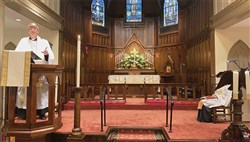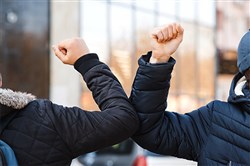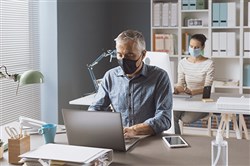VOL. 45 | NO. 7 | Friday, February 12, 2021
Is COVID-19 the death of shaking hands?
By Catherine Mayhew
On March 8, 2020, the 8:45 morning service at St. Paul’s Episcopal Church in Franklin was unfolding as it did every Sunday. Just after the Prayers of the People, the rector offered The Peace. “May the peace of the Lord be always with you,” Father Rusty McCown said to the congregation. “And also with you,” they responded.
Normally, they would turn to those closest to them in the pews and either shake hands if they didn’t know each other well or hug if they did.
But something was different. Not everyone shook hands. Or hugged. Some backed away and apologized for what seemed back in those days like abrupt rudeness and unwarranted caution.
Two days before that Sunday, 21 passengers on a California cruise ship tested positive for the coronavirus. The next day there were already 117 confirmed cases of the virus in the U.S., an increase of 34 in one day.
Three days later, the World Health Organization declared COVID-19 a pandemic. Eleven days later, St. Paul’s suspended all four in-person services at the almost 200-year-old historic church.
“Worship is just part of who we are and to say you can’t do that goes against what we’re called to do, which is to come together,” says Father McCown. “Not to do that has thrown everybody. The beauty of the church is everything.”
Shaking hands dates back to medieval times when people started employing the traditional greeting as a symbol of peace to show neither party was carrying a weapon. In 2020, our hands – swathed in sanitizer and washed for the duration of two rounds of “Happy Birthday to You” – became one of the ultimate weapons in fighting a deadly pandemic, along with wearing a mask and staying as far apart from each other as possible.
Hand shaking might be the most obvious loss of the past year, but it’s really on the surface of a larger question: Should the handshake should go away permanently, as some medical experts are recommending.
“I don’t think we should ever shake hands again, to be honest with you,” Anthony Fauci, M.D., the director of the National Institute of Allergy and Infectious Disease, told the Wall Street Journal last spring. “Not only would it be good to prevent coronavirus disease; it probably would decrease instances of influenza dramatically in this country.”
Gregory Poland, an infectious-disease expert at the Mayo Clinic, told The Atlantic magazine: “When you extend your hand, you’re extending a bioweapon.”
Well, alrighty then.
‘We got lax’
When will we feel safe going back to some semblance of a normal life?

Father Rusty McCown speaks during a pre-COVID-19 service at St. Paul’s Episcopal Church in Franklin. The church suspended in-person services as the pandemic became more dangerous.
The answers, such as they are, involve health concerns, psychological ramifications and what the nature of business will look like. But health care professionals are unanimous on one thing – success will be determined by a single word: Togetherness.
First, let’s talk a little science with Calvin Smith, M.D., an assistant professor of internal medicine at Meharry Medical College and a member of Nashville’s board of health.
“There is hope, and I want us to hold on to that hope, but we can’t have hope without togetherness,” he says. “Togetherness is the thing that will get us out of this. We all want to go back to a normal way of life.”
Smith says he is encouraged by the data so far.
“Based on what I know about the rates of infection, people are having robust immune responses, and the responses have been predictable,” he says. “That being said, the only route we really have if we want to do this quickly is vaccination. The herd immunity theory has been pretty much refuted. It’s not safe enough to rely on herd immunity without vaccination help.”
The spikes in cases based on the Christmas and New Years’ holidays were predictable, and now spring break looms.
“The biggest thing is we can’t make the same mistakes,” Smith adds. “We got lax. We need to be unified in our approach. My job has been exponentially harder. Everything is more difficult. I enjoy vacation. I enjoy beaches. I enjoy travel. I’m not able to do any of those things right now.”
“We’ve seen these spikes, and they don’t affect me because we need to be intentional about what we do regardless of the spikes,” says Thomas Williams, a Nashville Realtor who says he rigidly follows the health guidelines.
“I’m afraid if we drop our guard we’ll be in trouble again. I don’t know what’s going to be the demarcation point … maybe if they can say 90% of the people have been vaccinated with both shots.”
Smith says he misses vacations and travel, as do most of us. Last year made them distant goals and painfully absent realities. No wonder we got depressed. And, yes, research shows we are increasingly depressed.

So what replaces the handshake? Elbow bump? No, still too close for safe breathing. First bump? Same problem. How about a bow? The safest bet might be a wave – from a distance.
-- Shutterstock.ComThe Centers for Disease Control studied more than 5,000 adults across the country last summer for their responses to the disease, the impact of social distancing and stay-at home orders. Almost half reported at least one adverse mental health condition related to the pandemic, whether it be depression, anxiety or stress-related effects.
“Some of the hardest things for us to do is to deal with adversity and change,” explains Abhinav Saxena, M.D., assistant professor of clinical psychiatry and behavioral sciences at Vanderbilt University. “Like with any change there’s a little bit of a mourning period. People do that in different ways and there’s a wide array of what is OK.
“Everyone, especially parents who have a lot of responsibility, had to accept the idea that things have changed, more so than any other time in our lifetime. Some people were able to make things work better whether it was family or occupation. Others were worse affected. We did not all share an equal burden in all of this. It’s important to respect that and acknowledge that.”
Tami Newsom and Angie Batey have found that to be true. They are musicians at Farragut Presbyterian Church in Knoxville. Newsom is the associate director of music and organist, and Batey is the director of music as well as the associate dean for the College of Arts and Sciences at the University of Tennessee. But even though they’re professionals in the same field, they are experiencing different levels of loss.
“For someone like myself, my instrument is the organ,” Newsom says. “I’m used to sitting all day by myself making music with the tools that instrument affords me.
“But for Angie, it is a grim time. Her instrument is the voice. Her time as a conductor, teacher, choir director has been affected in that she no longer has the larger instrument of a choir to shape and create music. Sure, she has her own instrument, and being trained as a singer, is able to use that instrument in place of the choir in order to still contribute music to the worship service. But for her choir she has now become the voice, making music they so long to make themselves.”
The choir has suffered emotional loss as well.

We’ve gotten used to masks and social distancing at work, so who’s to say we can’t adapt to a handshake-free workplace?
-- Shutterstock.Com“This is hard for those who have been in choirs most of their adult life - this is their way of worshipping, serving,” she says. “Many of them have not been through the church doors since March, the one thing many of them who are now retired from their daily jobs looked forward to each week. It isn’t just church, but their social outlet as well. They miss the magic that occurs in the choir rehearsal, taking a piece of music from start, to finish, to worship. It is their gift to their fellow church members and their gift to God. How do you fill that void?”
Saxena thinks the results of this total disruption of routine and enforced isolation will have long-lasting effects.
“A lot of the psychological toll from the last 12 months will be felt in the next five years,” he explains. “Psychological toll is not as easy to point to cause and effect. But if folks are having a difficult time with more stress at home or more adversity at home folks can put up with that for a while. But when it goes on and on and on … after a while you see it in the future. We can only estimate the toll of kids not having a normal routine, folks not having access to preventative health care, not feeling safe.”
Realtor Williams feels worn down at this point.
“Now it’s like the water over the rock,” he says. “When you hear about friends dying and friends who are sick … as it goes on it just wears you down. The rock is now a pebble.”
The rules are ‘nonnegotiable’
The tunnel may be long and the light glimpsed only dimly, but in the business world there are a lot of efforts to get back to some kind of normal, in ways that, for now, do not involve handshakes.
For the moment, there are lots of substitutes. Some suggestions include clasping your hands over your heart, bowing or just waving.
Some favor the Namaste, a bow with hands in the prayer position, popular in yoga classes.
The elbow bump is a no-go. Nobody’s arms are long enough to maintain a distance of 6 feet.
Charles Starks, the president and CEO of the Music City Center is the ultimate people congregator. “We’re certainly in the people business,” Starks says. “Virtual doesn’t work real well for us.”
In fiscal year 2019, 495,934 people walked the halls of the convention center, generating more than $439 million in direct economic impact.
That ground almost to a halt in 2020 and early 2021, with ripple effects going far beyond Davidson County. National and international trade shows that normally call the Music City Center home bring in thousands of participants, hundreds of vendors and heavy-hitting sponsors that can generate their largest income of the year.
When they can’t meet, the economic impact runs deep. Starks says those shows are almost gone now until June at the earliest.
“If the cookie monster needs 100 cookies a day, we’re feeding him maybe one mini cookie a day,” he says.
Many of those shows are going on their second year without annual gatherings.
“A lot of trade shows or annual meetings will generate $5 million on a show,” he adds. “If they miss that second show – and all of them are starting to miss those second shows – they may go out of business. Nobody maintains rainy day funds for a two- to three-year period.”
The good news is that when guests come back in large numbers, they’ll be entering a building that is cleaner and more sanitary than it’s ever been. The facility is accredited by the Global Biorisk Advisory Council (GBAC), the worldwide cleaning industry association.
“Once we became certified with GBAC that was a huge help in talking to customers,” Starks says. “The good news when we started going through GBAC is we were doing 95% of what was required. That gives customers a great sense of relief.”
In February, the center has only one show of any size on its calendar, The Nashville Show - Antiques Art Vintage, which expects 2,500 attendees Feb. 12-13. But the rules for entry are strict. Tickets are required to be purchased early, there will be timed entry and exit for each ticket holder, and masks are required, period.
The show’s website puts it bluntly: “No exceptions and no medical exemptions – if you cannot wear a mask or face shield, do not purchase a ticket. There are no refunds and you will not be permitted entry.”
And that pretty much sums up the convention center’s policy as well.
“You have to have a mask or shield to come in here,” Starks points out. “The safety of the building stops with us. These are the rules and they’re nonnegotiable and if you can’t agree to that you can’t come.”
Waiting on science
So we end where we began. When can we shake hands again? And, of course, it goes beyond that. When can we feel safe around others? When can we travel? And what psychological scars will we carry with us?
“There’s no exact answer,” Saxena says. “You have to know yourself, know what your boundaries are, know what your limits are. Anyone who is able to remember 2020 knows it will never be the same again. We will never be the same again. We can never get the 2019 version of ourselves back again. But that doesn’t have to be a bad thing. We have to pick up the things we did that were resilient. All the things we leaned on to survive this thing.”
For Ellen Nelson, who works from her Nashville home as a writer and publicist, it’s the vaccination she eagerly anticipates. “I will be comfortable going out for pleasure rather than essential errands once I’ve been vaccinated. I try to find ways to support local businesses in the meantime. I miss people, laughter, hugging and socializing in general, but I will not risk my health or that of others until we have a better grasp on this pandemic.”
In Knoxville, Newsom is relying on science for the answer.
“When will we return? When the scientific community says it is safe. When vaccines have been administered. Will it ever look the same again? That is the scary part. We have been so ingrained with the notion of social distancing – how hard will it be to hug that first person, to stand shoulder to shoulder and sing when you have been drilled with the notion that aerosols are bad news? I think it is as much as physical as it is a mental retraining that will have to occur. I can assure you that we miss singing more than anyone can ever imagine.”
Smith thinks brighter days are ahead in late summer or early fall, but there’s a big question mark. “If all goes well, and if we can truly get buy in from everyone we’re looking at the end of summer or early fall that we can begin to be a little more lax about these protocols. That’s the best case.”
Williams shares Smith’s concern that the only way to get past this pandemic is if everyone works together to get vaccinated, continue to wear masks and socially distance.
“‘All’ is the key, he says. “Everyone has had a different feeling about this virus. Some people think it’s serious. Other people say it’s not a thing. And everything in between. It’s going to be interesting to see what ‘all’ is. We want this to be done right. We won’t get a second chance.”